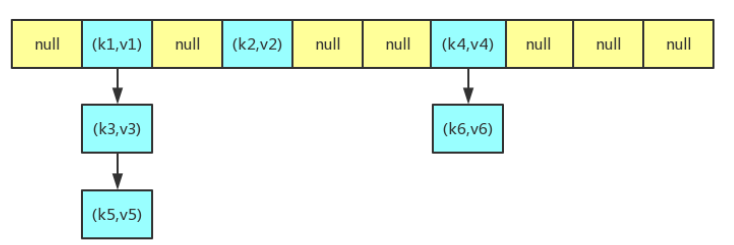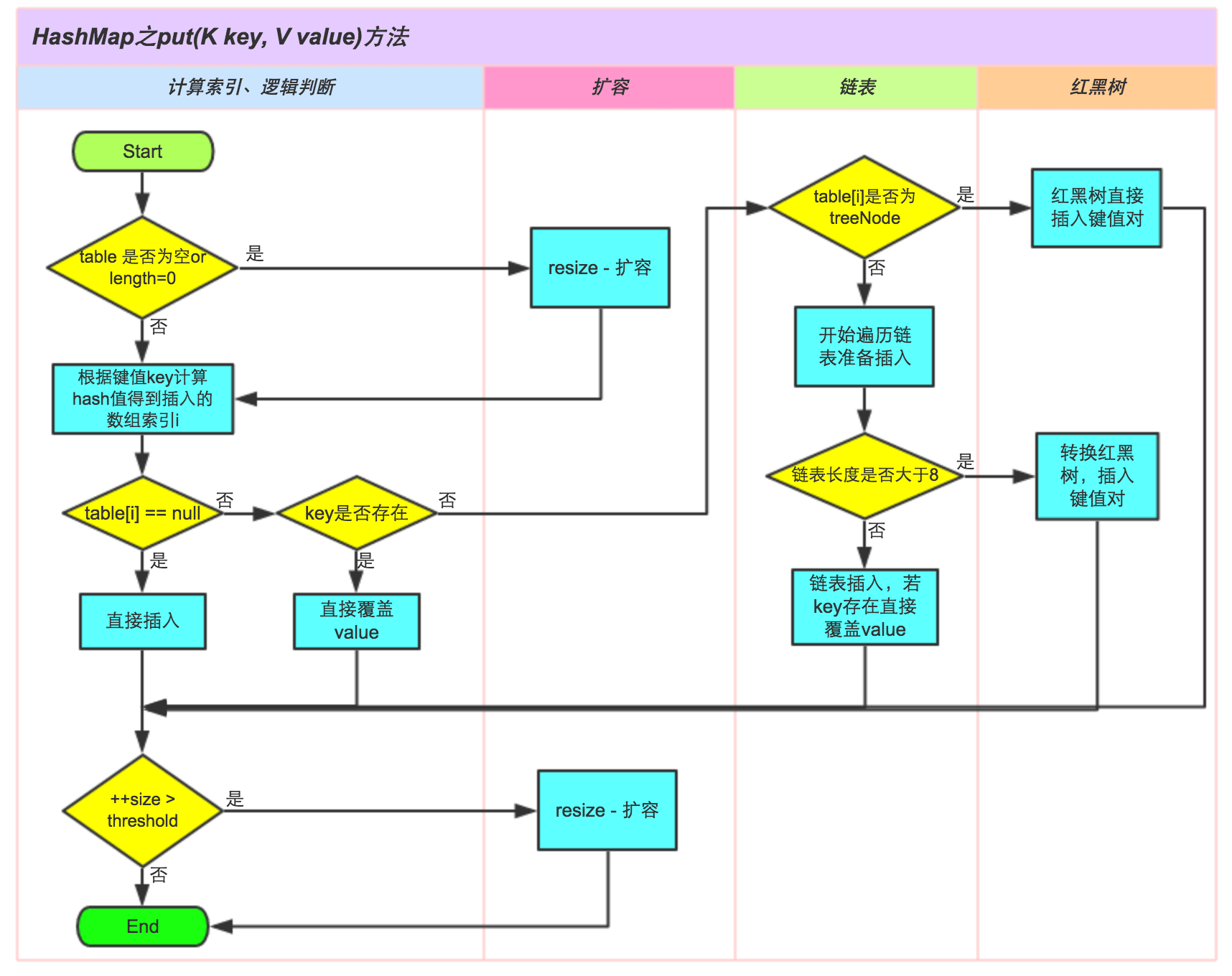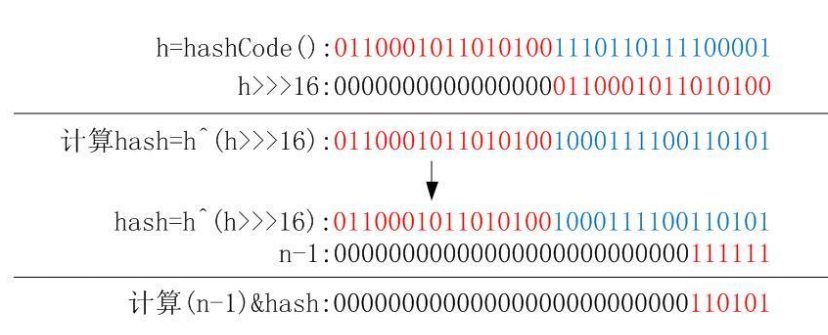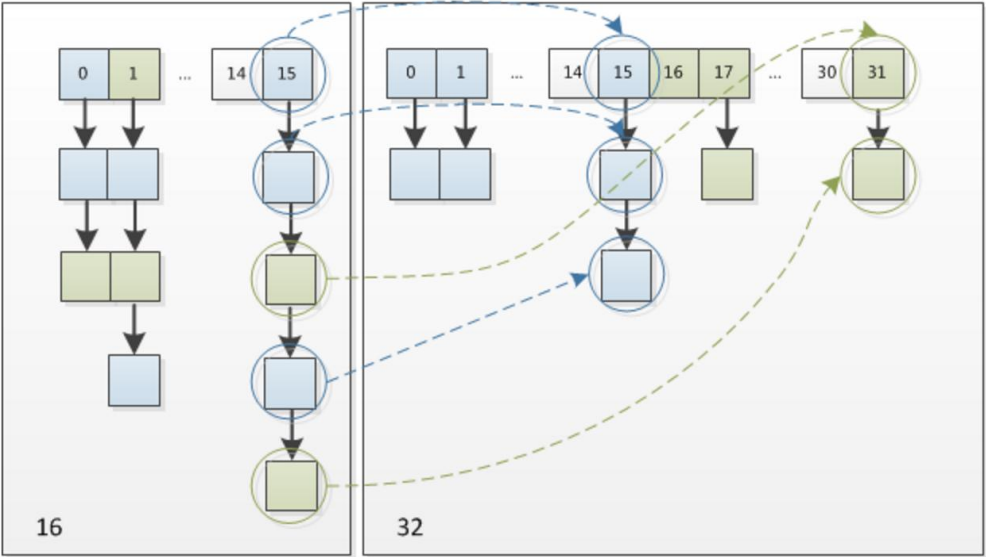一、概述
影响 HashMap 性能的两个重要参数:“initial capacity”(初始化容量)和”load factor“(负载因子)。简单来说,容量就是哈希表桶的个数,负载因子就是键值对个数与哈希表长度的一个比值,当比值超过负载因子之后,HashMap 就会进行 rehash操作来进行扩容。
HashMap 的大致结构如下图所示,其中哈希表是一个数组,我们经常把数组中的每一个节点称为一个桶,哈希表中的每个节点都用来存储一个键值对。在插入元素时,如果发生冲突(即多个键值对映射到同一个桶上)的话,就会通过链表的形式来解决冲突。因为一个桶上可能存在多个键值对,所以在查找的时候,会先通过 key 哈希值先定位到桶,再遍历桶上的所有键值对,找出 key 相等的键值对,从而来获取 value。

二、属性
/*** The table, initialized on first use, and resized as* necessary. When allocated, length is always a power of two.* (We also tolerate length zero in some operations to allow* bootstrapping mechanics that are currently not needed.)*/transient Node<K,V>[] table;/*** Holds cached entrySet(). Note that AbstractMap fields are used* for keySet() and values().* 保存键值对的Set集合*/transient Set<Map.Entry<K,V>> entrySet;/*** The number of key-value mappings contained in this map.* 键值对个数*/transient int size;/*** The number of times this HashMap has been structurally modified* Structural modifications are those that change the number of mappings in* the HashMap or otherwise modify its internal structure (e.g.,* rehash). This field is used to make iterators on Collection-views of* the HashMap fail-fast. (See ConcurrentModificationException).* 哈希表被修改次数*/transient int modCount;/*** The next size value at which to resize (capacity * load factor).* 它是通过 capacity*load factor 计算出来的,当 size 到达这个值时,就会进行扩容操作* @serial*/// (The javadoc description is true upon serialization.// Additionally, if the table array has not been allocated, this// field holds the initial array capacity, or zero signifying// DEFAULT_INITIAL_CAPACITY.)int threshold;/*** The load factor for the hash table.* 负载因子* @serial*/final float loadFactor;/*** The default initial capacity - MUST be a power of two.* 默认初始容量为16*/static final int DEFAULT_INITIAL_CAPACITY = 1 << 4; // aka 16/*** The maximum capacity, used if a higher value is implicitly specified* by either of the constructors with arguments.* MUST be a power of two <= 1<<30.* 最大容量上限为2^30*/static final int MAXIMUM_CAPACITY = 1 << 30;/*** The load factor used when none specified in constructor.* 默认负载因子为0.75*/static final float DEFAULT_LOAD_FACTOR = 0.75f;/*** The bin count threshold for using a tree rather than list for a* bin. Bins are converted to trees when adding an element to a* bin with at least this many nodes. The value must be greater* than 2 and should be at least 8 to mesh with assumptions in* tree removal about conversion back to plain bins upon* shrinkage.* 变成树型结构的链表长度临界值为 8*/static final int TREEIFY_THRESHOLD = 8;/*** The bin count threshold for untreeifying a (split) bin during a* resize operation. Should be less than TREEIFY_THRESHOLD, and at* most 6 to mesh with shrinkage detection under removal.* 恢复链式结构的链表长度临界值为 6*/static final int UNTREEIFY_THRESHOLD = 6;/*** The smallest table capacity for which bins may be treeified.* (Otherwise the table is resized if too many nodes in a bin.)* Should be at least 4 * TREEIFY_THRESHOLD to avoid conflicts* between resizing and treeification thresholds.* 当哈希表的大小超过这个阈值,才会把链式结构转化成树型结构,否则仅采取扩容来尝试减少冲突*/static final int MIN_TREEIFY_CAPACITY = 64;
Node 类,是 HashMap 中的一个静态内部类,哈希表中的每一个节点都是 Node 类型。我们可以看到,Node 类中有 4 个属性,其中除了 key 和value 之外,还有 hash 和 next 两个属性。hash 是用来存储 key 的哈希值的,next 是在构建链表时用来指向后继节点的。
/**
* Basic hash bin node, used for most entries. (See below for
* TreeNode subclass, and in LinkedHashMap for its Entry subclass.)
*/
static class Node<K,V> implements Map.Entry<K,V> {
final int hash;
final K key;
V value;
Node<K,V> next;
Node(int hash, K key, V value, Node<K,V> next) {
this.hash = hash;
this.key = key;
this.value = value;
this.next = next;
}
public final K getKey() { return key; }
public final V getValue() { return value; }
public final String toString() { return key + "=" + value; }
public final int hashCode() {
return Objects.hashCode(key) ^ Objects.hashCode(value);
}
public final V setValue(V newValue) {
V oldValue = value;
value = newValue;
return oldValue;
}
public final boolean equals(Object o) {
if (o == this)
return true;
if (o instanceof Map.Entry) {
Map.Entry<?,?> e = (Map.Entry<?,?>)o;
if (Objects.equals(key, e.getKey()) &&
Objects.equals(value, e.getValue()))
return true;
}
return false;
}
}
三、方法
1.get
//get方法内部调用了getNode方法
public V get(Object key) {
Node<K,V> e;
return (e = getNode(hash(key), key)) == null ? null : e.value;
}
final Node<K,V> getNode(int hash, Object key) {
Node<K,V>[] tab;
Node<K,V> first, e;
int n; K k;
//如果哈希表不为空 && key 对应的桶上不为空
if ((tab = table) != null && (n = tab.length) > 0 &&
(first = tab[(n - 1) & hash]) != null) {
//判断桶上第一个元素是否直接命中
if (first.hash == hash && // always check first node
((k = first.key) == key || (key != null && key.equals(k))))
return first;
//如果链表不止一个元素
if ((e = first.next) != null) {
//如果为红黑树调用红黑树的获取节点的方法
if (first instanceof TreeNode)
return ((TreeNode<K,V>)first).getTreeNode(hash, key);
//如果是链表则递归找到节点哈希值相等并且key值相等的元素
do {
if (e.hash == hash &&
((k = e.key) == key || (key != null && key.equals(k))))
return e;
} while ((e = e.next) != null);
}
}
return null;
}
2.put

public V put(K key, V value) {
return putVal(hash(key), key, value, false, true);
}
/**
* Implements Map.put and related methods.
*
* @param hash hash for key
* @param key the key
* @param value the value to put
* @param onlyIfAbsent if true, don't change existing value
* @param evict if false, the table is in creation mode.
* @return previous value, or null if none
*/
final V putVal(int hash, K key, V value, boolean onlyIfAbsent,
boolean evict) {
Node<K,V>[] tab;
Node<K,V> p;//代表桶上链表中第一个节点
int n, i;
//如果哈希表为空,则先创建一个哈希表
if ((tab = table) == null || (n = tab.length) == 0)
n = (tab = resize()).length;
//如果当前桶没有碰撞冲突,则直接把键值对插入
if ((p = tab[i = (n - 1) & hash]) == null)
tab[i] = newNode(hash, key, value, null);
else {
Node<K,V> e; K k;
//如果桶上节点的 key 与当前 key 重复,那你就是我要找的节点了
if (p.hash == hash &&
((k = p.key) == key || (key != null && key.equals(k))))
//如果桶上的第一个节点key的Hash值与key的值都相同,则用e引用p,并在最后边替换新值代码
e = p;
//如果是采用红黑树的方式处理冲突,则通过红黑树的 putTreeVal 方法去插入这个键值对
else if (p instanceof TreeNode)
e = ((TreeNode<K,V>)p).putTreeVal(this, tab, hash, key, value);
//否则就是传统的链式结构
else {
//采用循环遍历的方式,判断链中是否有重复的 key
for (int binCount = 0; ; ++binCount) {
//到了链尾还没找到重复的 key,则说明 HashMap 没有包含该键
if ((e = p.next) == null) {
//创建一个新节点插入到尾部
p.next = newNode(hash, key, value, null);
//如果链的长度大于 TREEIFY_THRESHOLD 这个临界值,则把链变为红黑树
if (binCount >= TREEIFY_THRESHOLD - 1) // -1 for 1st
treeifyBin(tab, hash);
break;
}
//找到了重复的 key
if (e.hash == hash &&
((k = e.key) == key || (key != null && key.equals(k))))
break;
p = e;
}
}
//这里表示在上面的操作中找到了重复的键,所以这里把该键的值替换为新值,并返回旧值
//如果onlyIfAbsent为true时,则不会覆盖旧的值
if (e != null) { // existing mapping for key
V oldValue = e.value;
if (!onlyIfAbsent || oldValue == null)
e.value = value;
afterNodeAccess(e);
return oldValue;
}
}
//修改次数+1
++modCount;
//判断是否需要进行扩容
if (++size > threshold)
resize();
afterNodeInsertion(evict);
return null;
}
put 方法比较复杂,实现步骤大致如下:
- 先通过 hash 值计算出 key 映射到哪个桶。
- 如果桶上没有碰撞冲突,则直接插入。
- 如果出现碰撞冲突了,则需要处理冲突
(1)如果该桶使用红黑树处理冲突,则调用红黑树的方法插入。
(2)否则采用传统的链式方法插入。如果插入以后新的链的长度到达临界值,则把链转变为红黑树。 - 如果桶中存在重复的键,则为该键替换新值。
- 如果加入的键值对以后 size 大于阈值,则进行扩容。
3.remove
public V remove(Object key) {
Node<K,V> e;
return (e = removeNode(hash(key), key, null, false, true)) == null ?
null : e.value;
}
final Node<K,V> removeNode(int hash, Object key, Object value,
boolean matchValue, boolean movable) {
Node<K,V>[] tab; Node<K,V> p; int n, index;
//如果当前 key 映射到的桶不为空
if ((tab = table) != null && (n = tab.length) > 0 &&
(p = tab[index = (n - 1) & hash]) != null) {
Node<K,V> node = null, e; K k; V v;
//如果桶上的节点就是要找的 key,则直接命中
if (p.hash == hash &&
((k = p.key) == key || (key != null && key.equals(k))))
node = p;
else if ((e = p.next) != null) {
//如果是以红黑树处理冲突,则构建一个树节点
if (p instanceof TreeNode)
node = ((TreeNode<K,V>)p).getTreeNode(hash, key);
//如果是以链式的方式处理冲突,则通过遍历链表来寻找节点
else {
do {
if (e.hash == hash &&
((k = e.key) == key ||
(key != null && key.equals(k)))) {
node = e;
break;
}
p = e;
} while ((e = e.next) != null);
}
}
//比对找到的 key 的 value 跟要删除的是否匹配
if (node != null && (!matchValue || (v = node.value) == value ||
(value != null && value.equals(v)))) {
//通过调用红黑树的方法来删除节点
if (node instanceof TreeNode)
((TreeNode<K,V>)node).removeTreeNode(this, tab, movable);
//使用链表的操作来删除节点
else if (node == p)
tab[index] = node.next;
else
p.next = node.next;
++modCount;
--size;
afterNodeRemoval(node);
return node;
}
}
return null;
}
4.hash
在 get 方法和 put 方法中都需要先计算 key 映射到哪个桶上,然后才进行之后的操作,(n - 1) & hash,代码中的 n 指的是哈希表的大小,hash 指的是 key 的哈希值,hash 是通过下面这个方法计算出来的,采用了二次哈希的方式,其中 key 的 hashCode 方法是一个native 方法:
static final int hash(Object key) {
int h;
return (key == null) ? 0 : (h = key.hashCode()) ^ (h >>> 16);
}
这个 hash 方法先通过 key 的 hashCode 方法获取一个哈希值,再拿这个哈希值与它的高 16 位的哈希值做一个异或操作来得到最后的哈希值,计算过程可以参考下图。为啥要这样做呢?注释中是这样解释的:如果当 n(哈希表的长度) 很小,假设为 64 的话,那么 n-1即为 63(0x111111),这样的值跟 hashCode()直接做与操作,实际上只使用了哈希值的后 6 位。如果当哈希值的高位变化很大,低位变化很小,这样就很容易造成冲突了,所以这里把高低位都利用起来,从而解决了这个问题。

正是因为与的这个操作,决定了 HashMap 的大小只能是 2 的幂次方,当容量一定是2^n时,hash& (length - 1) == hash % length,它俩是等价不等效的,位运算效率非常高,实际开发中,很多的数值运算以及逻辑判断都可以转换成位运算,但是位运算通常是难以理解的,因为其本身就是给电脑运算的,运算的是二进制,而不是给人类运算的,人类运算的是十进制,这也是位运算在普遍的开发者中间不太流行的原因(门槛太高)。这个等式实际上可以推理出来,2^n转换成二进制就是1+n个0,减1之后就是0+n个1,如16 -> 10000,15 -> 01111,那根据&位运算的规则,都为1(真)时,才为1,那0≤运算后的结果≤15,假设hash <= 15,那么运算后的结果就是h本身,hash >15,运算后的结果就是最后三位二进制做&运算后的值,最终,就是%运算后的余数,这就是容量必须为2的幂的原因。
即使你在创建 HashMap 的时候指定了初始大小,HashMap 在构建的时候也会调用下面这个方法来调整大小:
/**
* Returns a power of two size for the given target capacity.
*/
static final int tableSizeFor(int cap) {
int n = cap - 1;
n |= n >>> 1;//n=n|(n>>>1)
n |= n >>> 2;
n |= n >>> 4;
n |= n >>> 8;
n |= n >>> 16;
return (n < 0) ? 1 : (n >= MAXIMUM_CAPACITY) ? MAXIMUM_CAPACITY : n + 1;
}
它的实际作用就是把 cap 变成第一个大于等于 2 的幂次方的数。例如,16 还是 16,13 就会调整为 16,17 就会调整为 32。
5,resize
HashMap 在进行扩容时,使用的 rehash 方式非常巧妙,因为每次扩容都是翻倍,与原来计算(n-1)&hash 的结果相比,只是多了一个 bit 位,所以节点要么就在原来的位置,要么就被分配到“原位置+旧容量”这个位置。
例如,原来的容量为 16,那么应该拿 hash 跟 15(0x1111)做与操作;在扩容扩到了 32 的容量之后,应该拿 hash 跟 31(0x11111)做与操作。新容量跟原来相比只是多了一个 bit 位,假设原来的位置在 5,那么当新增的那个 bit 位对应的Hash值为0,与31与运算后结果不变,该节点还是在 5;相反,如果新增的那个 bit 位对应的Hash值为1,那么经过与运算之后,则该节点会被分配到 5+16 的桶上。

正是因为这样巧妙的 rehash 方式,保证了 rehash 之后每个桶上的节点数必定小于等于原来桶上的节点数,即保证了 rehash 之后不会出现更严重的冲突。
因此,我们在扩充 HashMap 的时候,不需要像 JDK1.7 的实现那样重新计算 hash,只需要看看原来的 hash 值新增的那个 bit 是 1 还是 0 就好了,是 0 的话索引没变,是 1 的话索引变成“原索引+oldCap”,可以看看下图为 16 扩充为 32 的 resize 示意图

这个设计确实非常的巧妙,既省去了重新计算 hash 值的时间,而且同时,由于新增的 1bit 是 0还是1可以认为是随机的,因此resize的过程,均匀的把之前的冲突的节点分散到新的bucket了。这一块就是 JDK1.8 新增的优化点。
final Node<K,V>[] resize() {
Node<K,V>[] oldTab = table;
int oldCap = (oldTab == null) ? 0 : oldTab.length;
int oldThr = threshold;
int newCap, newThr = 0;
//计算扩容后的大小
if (oldCap > 0) {
//如果当前容量超过最大容量,则无法进行扩容
if (oldCap >= MAXIMUM_CAPACITY) {
threshold = Integer.MAX_VALUE;
return oldTab;
}
//没超过最大值则扩为原来的两倍
else if ((newCap = oldCap << 1) < MAXIMUM_CAPACITY &&
oldCap >= DEFAULT_INITIAL_CAPACITY)
newThr = oldThr << 1; // double threshold
}
else if (oldThr > 0) // initial capacity was placed in threshold
newCap = oldThr;
else { // zero initial threshold signifies using defaults
newCap = DEFAULT_INITIAL_CAPACITY;
newThr = (int)(DEFAULT_LOAD_FACTOR * DEFAULT_INITIAL_CAPACITY);
}
if (newThr == 0) {
float ft = (float)newCap * loadFactor;
newThr = (newCap < MAXIMUM_CAPACITY && ft < (float)MAXIMUM_CAPACITY ?
(int)ft : Integer.MAX_VALUE);
}
//新的 resize 阈值
threshold = newThr;
//创建新的哈希表
@SuppressWarnings({"rawtypes","unchecked"})
Node<K,V>[] newTab = (Node<K,V>[])new Node[newCap];
table = newTab;
if (oldTab != null) {
//遍历旧哈希表的每个桶,重新计算桶里元素的新位置
for (int j = 0; j < oldCap; ++j) {
Node<K,V> e;
if ((e = oldTab[j]) != null) {
oldTab[j] = null;
//如果桶上只有一个键值对,则直接插入
if (e.next == null)
newTab[e.hash & (newCap - 1)] = e;
//如果是通过红黑树来处理冲突的,则调用相关方法把树分离开
else if (e instanceof TreeNode)
((TreeNode<K,V>)e).split(this, newTab, j, oldCap);
//如果采用链式处理冲突
else { // preserve order
//以链表形式存放不需要转移的节点
Node<K,V> loHead = null, loTail = null;
//存放需要转移位置的节点
Node<K,V> hiHead = null, hiTail = null;
Node<K,V> next;
//通过上面讲的方法来计算节点的新位置
do {
next = e.next;
//说明当前Node的HashCode对应于新增的bit位是0,即当前节点不转移槽位
if ((e.hash & oldCap) == 0) {
if (loTail == null)
loHead = e;
else
loTail.next = e;
loTail = e;
}
//说明当前Node的HashCode对应于新增的bit位是1,即当前节点需要转移槽位
else {
if (hiTail == null)
hiHead = e;
else
hiTail.next = e;
hiTail = e;
}
} while ((e = next) != null);
if (loTail != null) {
loTail.next = null;
newTab[j] = loHead;
}
if (hiTail != null) {
hiTail.next = null;
newTab[j + oldCap] = hiHead;
}
}
}
}
}
return newTab;
}
当哈希表中的键值对个数超过阈值(哈希表长度与负载因子的乘积)时,才进行扩容的

